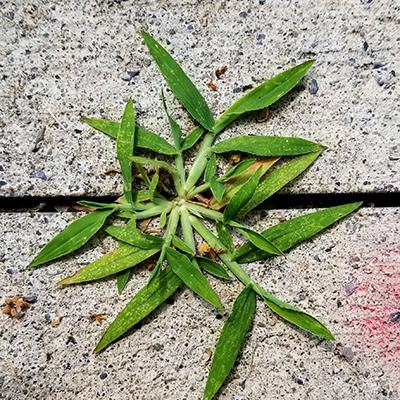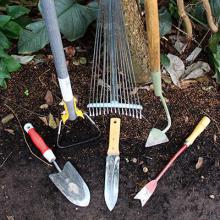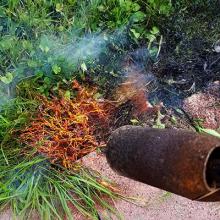
Although patios, pavement, and cement are not themselves hospitable environments for plant growth, hard surfaces can be plagued by weeds if not managed. Weeds grow very easily in gaps present in hard surfaces such as cracks, joints, and depressions in which soil is allowed to settle.
This can be disruptive and/or cause damage by:
- Making hard surfaces uneven and slippery
- Causing and expanding cracks in pavement
- Destabilizing joints and seals
- Shortening the lifespan of hard surfaces
Monitor
Monitor hard surfaces and adjacent areas for weeds and make note if you see a novel weed. Proper identification is key to good weed management and helps you select appropriate management techniques.
Keep these tips in mind when monitoring your landscapes and hard surfaces:
- Monitor and control weeds of hard surface edges. Weeds are more likely to spread from areas close to vegetation inwards.
- Watch out for nearby vegetatively reproducing weeds. They may spread under pavement and grow through cracks and joints.
Prevent
Prevention can be the most effective type of weed control. If possible, preventive weed management should be executed before you have a weed problem. By getting ahead of the problem, you will save time and money associated with controlling already established weeds.
Preventive measures include:
- Sealing cracks and breaks in pavement
- Filling joints between bricks and pavers. One option is polymeric sand which becomes solid when activated with water.
- Minimize soil accumulation in depressions, cracks, joints, and other openings through regular sweeping. This reduces the chance of weed establishment.
- Pull or cut weeds before they form seed heads to minimize seed rain.
- Clean gardening tools between each use to minimize weed seed transport.
Control Options Details
Mechanical Control
Weeds can be removed from hard surfaces manually and mechanically. While removing weeds from joints, cracks, and crevices can be difficult, certain methods and tools can be used to make this process easier:
- Wet the soil prior to weeding especially when removing weeds with sizable taproots such as docks or dandelion
- Use a block paving brush to remove weeds from joints and other crevices. Works best on mosses and small, non-established weeds.
- Use a block paving knife to remove weeds from joints and other crevices.
Thermal Weeding
Flame weeding can be used on hard surfaces including pavement, cement, brick, and pavers. It best controls annual broadleaf weeds, but can be effective against perennials with repeated applications.
For instructions and tips for flame weeding, please visit the Thermal Weeding page under Pesticide-free Control Options.


